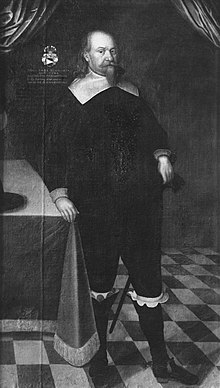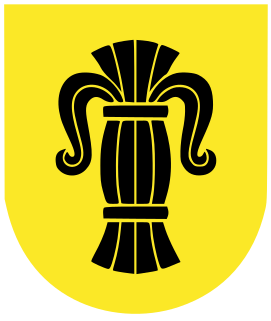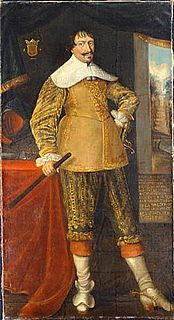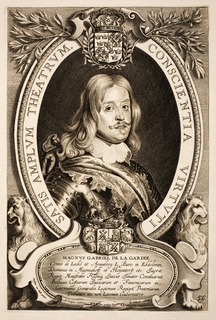| Per Gustafsson Banér | |
|---|---|
Per Banér in 1642 | |
| Governor of Swedish Estonia | |
| In office 1622–1626 | |
| Preceded by | Jacob De la Gardie |
| Succeeded by | Johan De la Gardie |
| Personal details | |
| Born | June 28, 1588 Djursholm, Sweden |
| Died | July 13, 1644 (aged 56) Stockholm, Sweden |
| Spouse(s) | Hebbla Fleming (m. 1615–39; her death) |
| Children | Gustaf Persson Banér |
Per Gustafsson Banér, also known as Peder Gustafsson Banér (28 June 1588 – 13 July 1644) was a Swedish nobleman and member of the Privy Council of Sweden. [1]

The Council of the Realm, or simply The Council, was a cabinet of medieval origin, consisting of magnates which advised, and at times co-ruled with, the King of Sweden.
Banér was the son of Gustaf Banér who was one of the noblemen executed in 1600 at the Linköping Bloodbath, and Kristina Sture, daughter of Svante Stensson Sture.

Gustaf Banér was a Swedish noble, member of the Privy Council of Sweden.
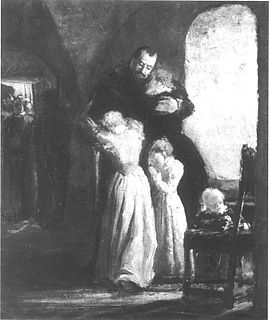
The Linköping Bloodbath on 20 March 1600 was the public execution by beheading of five Swedish nobles in the aftermath of the War against Sigismund (1598–1599), which resulted in the de facto deposition of the Polish and Swedish King Sigismund III Vasa as king of Sweden. The five were advisors to Catholic Sigismund or political opponents of the latter's uncle and adversary, the Swedish regent Duke Charles.
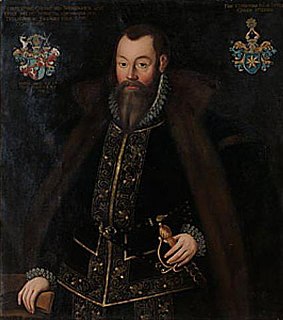
Svante Stensson Sture or Svante Sture the Younger was a Swedish count, riksmarsk and statesman. From 1562 to 1564, during the Livonian War, he was governor of Estonia.
He became a kammarjunkare to king Gustavus Adolphus in 1611, and followed the king on his incursion into Skåne in 1612. At the Battle of Vittsjö, Banér helped save the king from drowning, and the grateful king made him a chamberlain and conferred on him the estates of Banér's uncle Sten Axelsson Banér, who had also been executed at the Linköping bloodbath. In 1617, when Gustavus Adolphus was crowned, Banér was knighted. [1]

Valet de chambre, or varlet de chambre, was a court appointment introduced in the late Middle Ages, common from the 14th century onwards. Royal households had many persons appointed at any time. While some valets simply waited on the patron, or looked after his clothes and other personal needs, itself potentially a powerful and lucrative position, others had more specialized functions. At the most prestigious level it could be akin to a monarch or ruler's personal secretary, as was the case of Anne de Montmorency at the court of Francis I of France. For noblemen pursuing a career as courtiers, like Étienne de Vesc, it was a common early step on the ladder to higher offices.

Gustavus Adolphus, also known in English as Gustav II Adolf or Gustav II Adolph, was the King of Sweden from 1611 to 1632 who is credited for the founding of Sweden as a great power. He led Sweden to military supremacy during the Thirty Years' War, helping to determine the political as well as the religious balance of power in Europe. He was formally and posthumously given the name Gustavus Adolphus the Great by the Riksdag of the Estates in 1634.
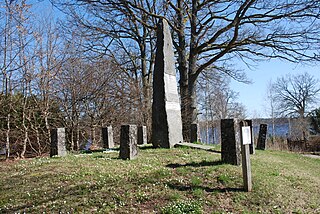
The Battle of Vittsjö was a battle between Sweden and Denmark-Norway that took place in 1612; it was more a case of the Swedes fleeing the Danes than a full-scale battle.
He married Hebbla Fleming in 1615. [2] Their son Gustaf Persson Banér was born in 1618. [3] Hebbla Fleming died in 1639. [4]
From 1622 to 1624, Banér was governor of Estonia and in 1625 he was made a member of the Privy Council. [1] He was Lawspeaker for Öland and Östergötland from 1627. [2]

Estonia, officially the Republic of Estonia, is a country in Northern Europe. It is bordered to the north by the Gulf of Finland with Finland on the other side, to the west by the Baltic Sea with Sweden on the other side, to the south by Latvia (343 km), and to the east by Lake Peipus and Russia (338.6 km). The territory of Estonia consists of a mainland and 2,222 islands in the Baltic Sea, covering a total area of 45,227 km2 (17,462 sq mi), water 2,839 km2 (1,096 sq mi), land area 42,388 km2 (16,366 sq mi), and is influenced by a humid continental climate. The official language of the country, Estonian, is the third most spoken Finno-Ugric language.

A lawspeaker or lawman is a unique Scandinavian legal office. It has its basis in a common Germanic oral tradition, where wise people were asked to recite the law, but it was only in Scandinavia that the function evolved into an office. Two of the most famous lawspeakers are Snorri Sturluson and Torgny the Lawspeaker.
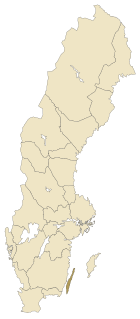
Öland is the second largest Swedish island and the smallest of the traditional provinces of Sweden. Öland has an area of 1,342 square kilometres and is located in the Baltic Sea just off the coast of Småland. The island has 26,000 inhabitants. It is separated from the mainland by the Kalmar Strait and connected to it by the 6-kilometre (3.7 mi) Öland Bridge, which opened on 30 September 1972.
His estate included Ekenäs Castle, which he rebuilt into a Renaissance style castle between 1630 and 1644. [5]

Ekenäs Castle is a castle located outside Linköping in Linköping Municipality, Östergötland, South-East Sweden. The present castle was built in the 17th century on top of the foundations of a medieval fortress from the 14th century. The lake surrounding the castle hill created a natural defense; however, this was drained in the late 19th century to create more arable land in the area.
Banér served under Axel Oxenstierna and acted as Oxenstierna's deputy when the latter assisted Gustavus Adolphus in Germany during the Thirty Years' War. Oxenstierna was however not entirely satisfied with Banér, who was often ill and suffered from bouts of melancholia, [4] and did not act with sufficient force to please his superiors. [1] [2]
On 20 June 1644, Banér was suddenly taken ill with a fever, and he died three weeks later, on 13 July. He was buried in Riddarholmskyrkan. [4]
